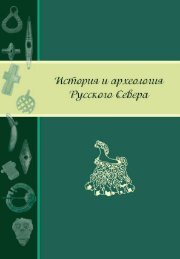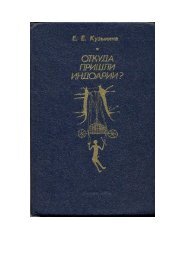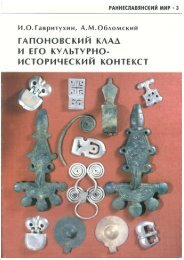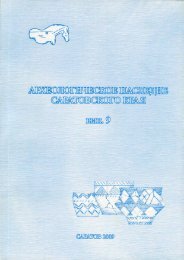The Archaeology of Celtic Art
The Archaeology of Celtic Art
The Archaeology of Celtic Art
- No tags were found...
Create successful ePaper yourself
Turn your PDF publications into a flip-book with our unique Google optimized e-Paper software.
LATER BRONZE AGE AND HALLSTATT ORIGINSwhich permitted hollow casting by the use <strong>of</strong> plugs within the mould. Alloys too wereincreasingly deployed in a more sophisticated fashion depending upon the method <strong>of</strong>construction or the requirements <strong>of</strong> different parts <strong>of</strong> the artefact in question; so, forexample, the body, base and handles <strong>of</strong> a bronze bucket might require the use <strong>of</strong> alloys<strong>of</strong> different composition. <strong>The</strong> use <strong>of</strong> sheet bronze was an important innovation. Usedvariously for the different components <strong>of</strong> the feasting or drinking service, buckets formixing drink, strainers and cups for serving and consuming it, beaten bronze was alsoused for high-status parade armour, including breast armour and greaves by the laterBronze Age. Embossing techniques not only added ornament and doubtless symbolismto these prestigious possessions, but lent strength to the sheet bronze construction.Specialist techniques, like the use <strong>of</strong> rivets to link panels <strong>of</strong> sheet bronze or wiredrawingto reinforce the rims <strong>of</strong> beaten bronze vessels, were the natural concomitant <strong>of</strong>these developments. But the crucial point about these innovations for the understanding<strong>of</strong> the cultural milieu that saw the genesis <strong>of</strong> early <strong>Celtic</strong> art is that these technicalskills were deployed for the aristocratic pursuits <strong>of</strong> feasting and drinking and theconflict <strong>of</strong> arms, or the ceremonial and symbolic associated with these activities.It is not simply the extension <strong>of</strong> technical capacity and therefore <strong>of</strong> the range <strong>of</strong> typesthat makes the late Bronze Age a period <strong>of</strong> dynamic change, it is also the scale <strong>of</strong>production. Hoards <strong>of</strong> the period are not infrequently substantial in quantity, promptingquestions regarding the reasons for their burial and non-recovery. Ritual depositionand the conspicuous destruction <strong>of</strong> wealth as a demonstration <strong>of</strong> social status have bothbeen invoked as possible motives for hoards, but the probability must also be consideredthat there was some serious disruption <strong>of</strong> the political and social order inCentral and South-Eastern Europe, perhaps not unrelated to the apparent collapse <strong>of</strong>Mycenaean civilization at the end <strong>of</strong> Late Helladic IIIB in the thirteenth century.Climatic deterioration is sometimes suggested as a cause for economic and politicalturmoil, bringing pressures upon land marginal for settlement and agriculture, andprompting strife between advantaged and displaced communities. At the same timeindustrial production on this scale itself requires a degree <strong>of</strong> political stability, not leastbecause the sources <strong>of</strong> supply, the twin mineral deposits <strong>of</strong> copper and tin, are widelydispersed, and stable political relationships would be required to ensure a continuingsupply <strong>of</strong> raw material across the trade routes <strong>of</strong> north-alpine Europe.Sources <strong>of</strong> raw materials for metal-workers in the Bronze Age were doubtless alreadythose that were later to be exploited by Iron Age bronze-workers and their patrons.Copper was available in plentiful supply in the eastern Alps, in the Balkans, theCarpathians and in Ireland; tin was not so widely available, but Cornish and Breton tinwas doubtless in demand, together with supplies from Spain, Italy and the OreMountains <strong>of</strong> Eastern Europe. Gold had been exploited from the early Bronze Age,with Irish and Carpathian sources being worked from an early period. <strong>The</strong> industrialinfrastructure plainly involved long-distance connections, and affords one obviousmechanism for the transmission <strong>of</strong> foreign fashions in artefact types and ornamentalstyles.Funerary practice and ritual<strong>The</strong> most fundamental change in burial practice represented in the late Bronze Age inEurope is the widespread adoption <strong>of</strong> cremation as the funerary rite. <strong>The</strong> north-alpine18
















